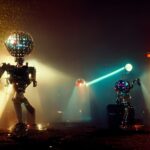When we think of artificial intelligence (AI), productivity and efficiency often come to mind first. But have we overlooked creative potential? As AI advances, should we be actively exploring collaborations that cultivate creativity too?
The Default Focus on Productivity
It’s understandable why businesses optimize AI for productivity – scheduling meetings, processing data, recommending products. These practical use cases meet immediate needs. And it’s technically easier to train AI within defined domains that have clear right answers.
But are we selling AI short by only focusing on productivity?
Expanding Horizons with AI Creativity
What if we explored collaborating with AI in more open-ended creative capacities, beyond just productivity? The results could potentially catalyze innovations that propel society forward.
AI is showing promise in certain narrowly defined creative applications. Within constrained domains, it can hypothesize new proteins, suggest engineering designs, or identify unseen patterns in data.
AI can also help train and support human creators. For example, musicians may riff off novel melodies suggested by AI to spark new compositions. Designers may incorporate alien, unexpected elements surfaced by AI into their work, stretching creative boundaries. Through thoughtful human-AI collaboration, we may be able to enhance and augment human imagination in profound ways.
But fully replicating the depths of human creativity and ingenuity remains beyond AI’s current capabilities. The most imaginative art still requires lived experiences and emotional wisdom that AI lacks. We must be mindful of AI’s limitations compared to the spark of human inspiration.
The Irreplaceable Spark of Human Inspiration
Human creativity is unique because it is inspired by our lived experiences. We weave our skills, observations, and emotions into our art, creating something that is both resonating and surprising. AI cannot do this because it does not have lived experiences to draw from. It has a long way to go to match genuine human creativity.
Comparing the Strengths of Two Minds: Human and Artificial
Human strengths:
- Creativity – stemming from experiences, skills, emotions that AI can’t authentically replicate
- Originality – humans provide the ingenuity spark beyond AI’s data
- Emotional intelligence – AI can only mimic, not actually feel
- Intuition – gut instinct from accumulated experiences
- Complex problem-solving – understanding nuances and physically acting
AI strengths:
- Knowledge – no human can match its vast data capacity
- Processing power – able to crunch data and find patterns faster than humans
- Improving from data – can expand skills by training on new info
- Repetitive tasks – excels at high-precision, high-volume work
- Narrow problem-solving – can solve tightly defined problems
So what? While no match for human creativity yet, AI can enhance creative workflows. The future promises a synthesis of artificial and biological imagination. But emotionally resonant creativity comes from within.
Unlocking Creativity Between Humans and AI
Rigid programming and limited datasets restrain AI creativity for now. But we must thoughtfully nurture it while valuing human gifts.
Now what?
Designers, musicians, and programmers should collaborate with AI, complementing each other’s strengths. Let’s encourage interdisciplinary teams to explore this potential. Provide AI with space to experiment freely. Mind the gaps compared to human creativity, but don’t fear AI’s role either. Together, we can shape AI creativity to advance culture, science, and technology in wondrous new ways.





